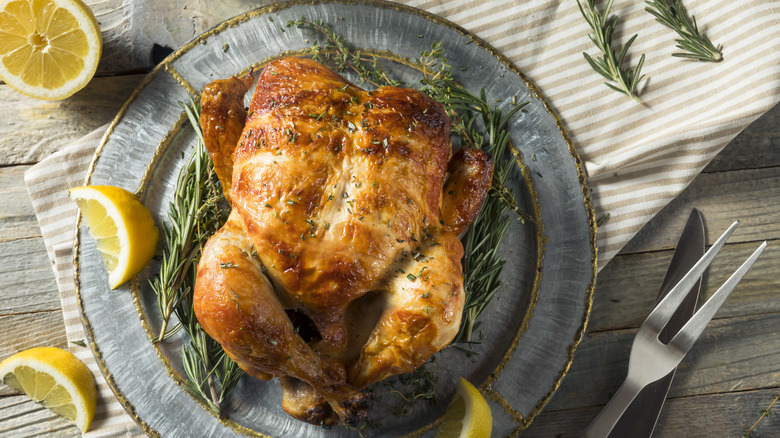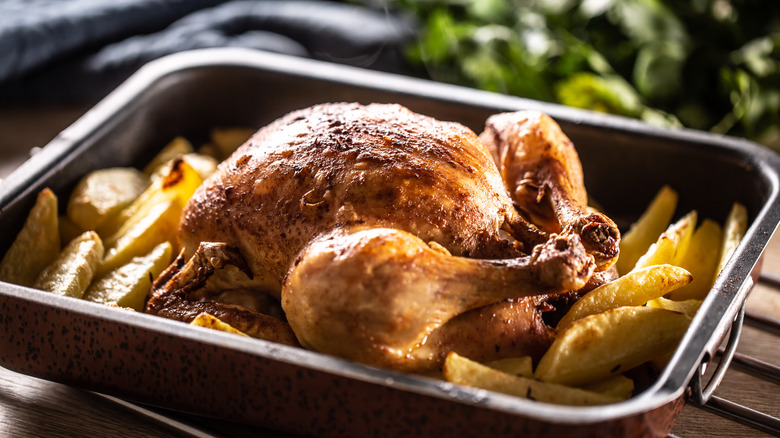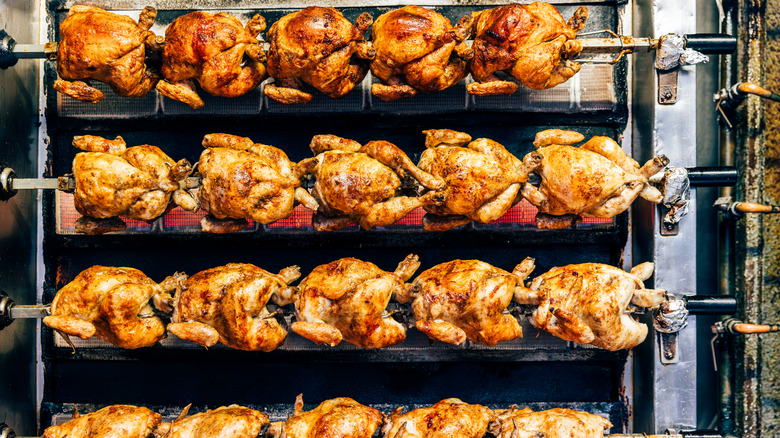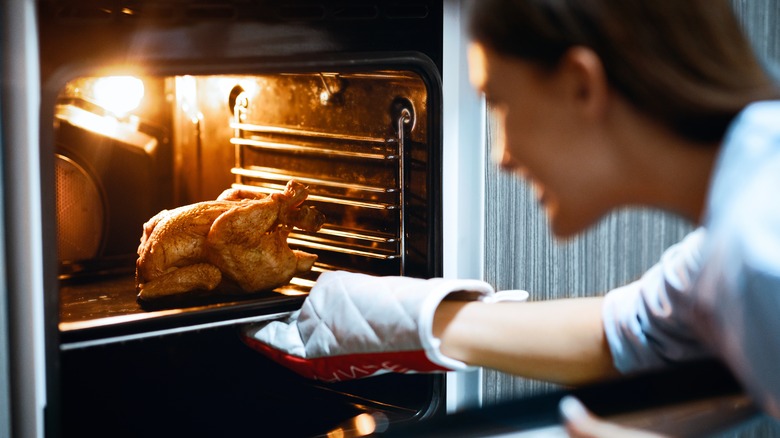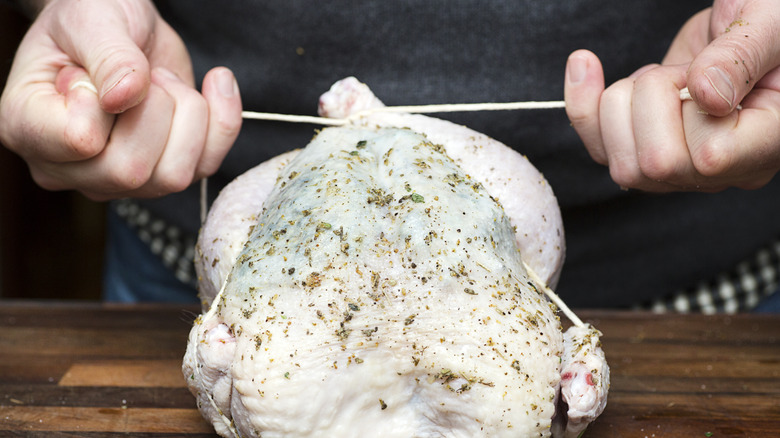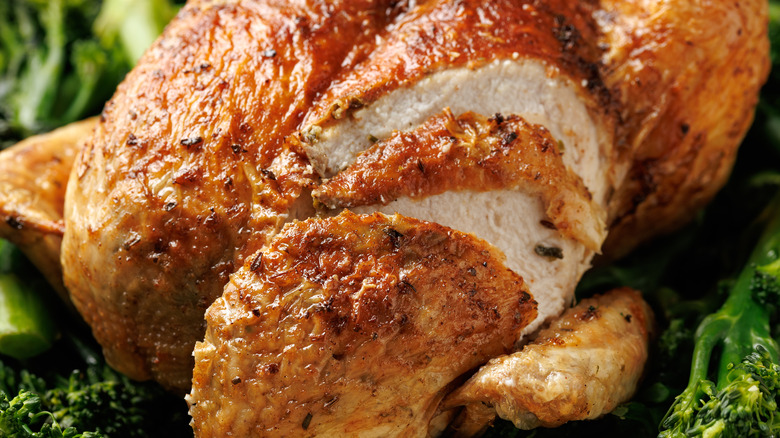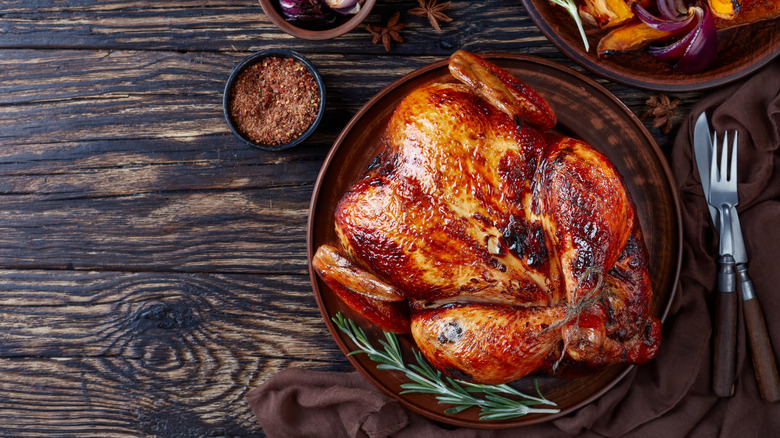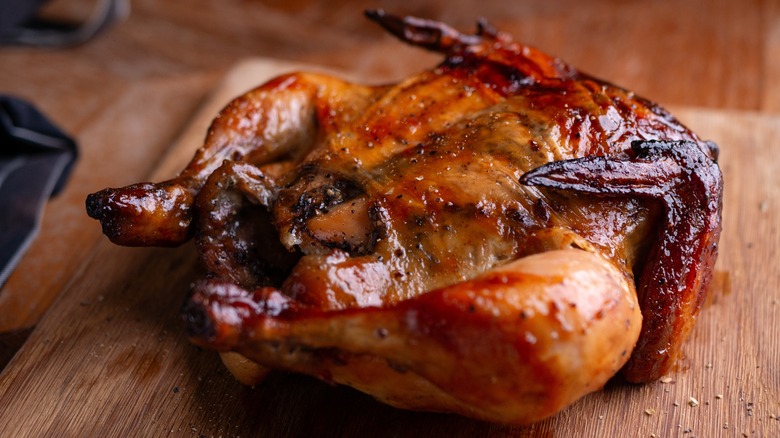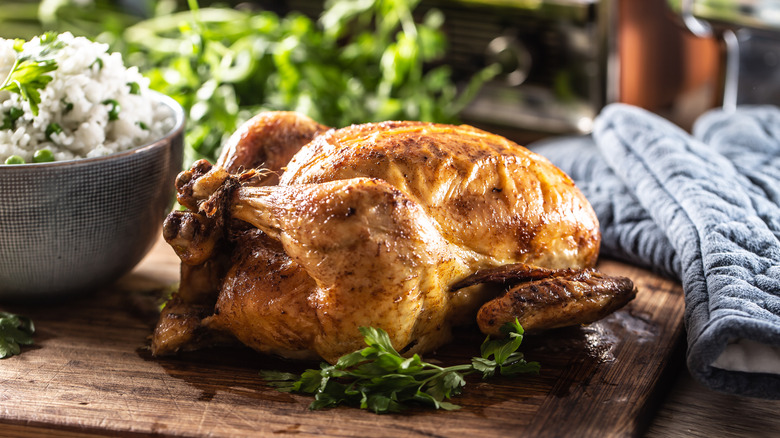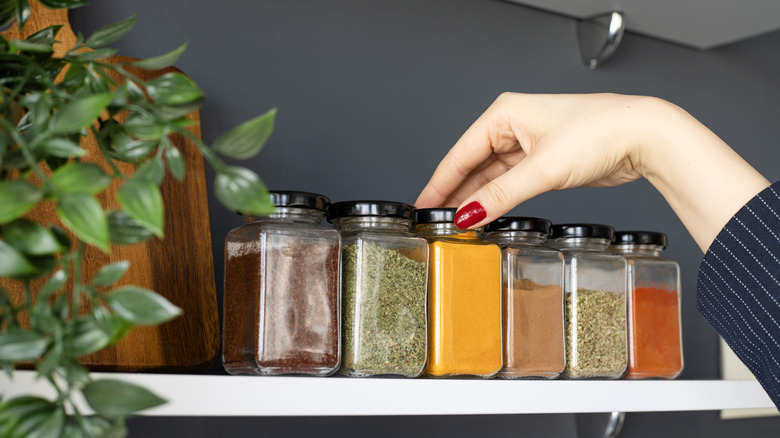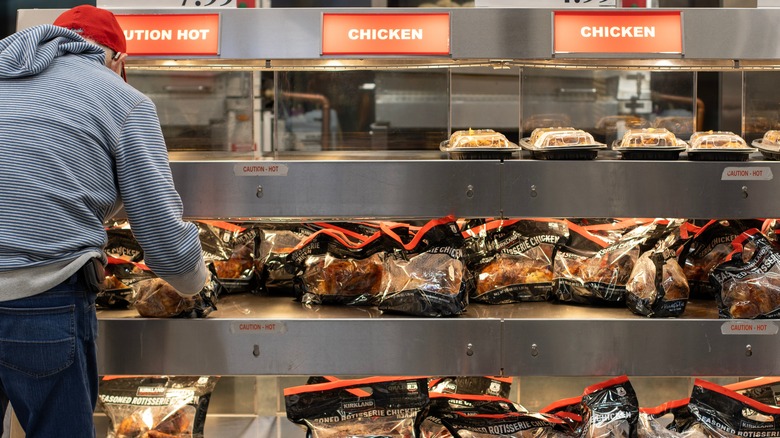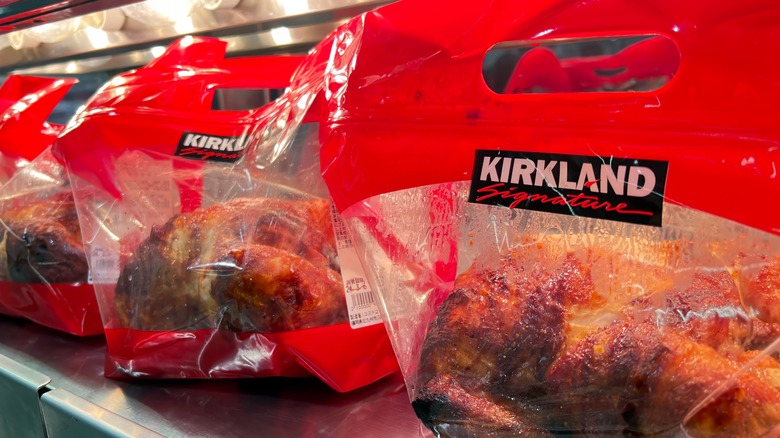Rotisserie Chicken Vs Roasted: What Experts Say The Difference Is
You grab that golden rotisserie chicken from the grocery store and think, "This is basically the same as roasting at home, right?" Well, not exactly. While both methods will get you delicious chicken, what is happening behind the scenes is actually pretty fascinating. The way fat moves around, the different heat sources doing the work, and a bunch of other factors all add up to create real differences in how crispy the skin gets, how the flavors develop, and how juicy everything turns out.
To understand these differences, we consulted two culinary experts with extensive experience in both techniques. Scott Groth is a trained chef and author of the blog I'd Rather be a Chef. In a past life, Scott owned a cooking school and a catering company, and now he puts that knowledge to use creating delicious recipes for a wide range of diets including low carb, keto, vegetarian and traditional old world cooking. We also spoke with chef Dayne Womax, the head chef at Rizzuto's Prime, located inside the New Orleans Hyatt Regency Hotel. Specializing in premium seafood, steaks, and classic Italian cuisine, Rizzuto's Prime delivers a sophisticated dining experience in the heart of New Orleans. These experts explained the key differences between the two types of cooking chicken to us.
Roasting: The technical process
Both Scott Groth and Dayne Womax agree on the fundamentals. Roast chicken gets cooked in an oven using dry heat. The sweet spot for temperature falls between 375 F and 425 F, and is cooked until the internal temperature hits 165 F at the thickest part, which is typically the inner thigh. It is all about that steady, even heat working its magic.
The oven mechanics play a huge role in how roasting works. Conventional ovens create natural air circulation as hot air rises and cooler air sinks, creating gentle movement around the chicken. Convection ovens take this further by actively circulating hot air with fans. Over at Rizzuto's, they use this professional convection approach where that circulating hot air helps render the fat, crisp the skin, and cook everything uniformly.
The dry heat from the oven pulls moisture from the surface of the chicken and a chemical process known as the Maillard effect occurs as the proteins and sugars react together under the heat. This generates hundreds of flavor compounds that give roasted chicken its distinctive deep, rich taste. Unlike other cooking methods where steam might get trapped, roasting allows moisture to escape freely, which is essential for developing that crispy, golden skin.
Rotisserie: The technical process
There is something almost hypnotic about watching a rotisserie chicken slowly spinning behind that glass case at the grocery store. But beyond the mesmerizing rotation, rotisserie cooking operates on a completely different principle than your standard oven roasting. Instead of dry heat circulating around the bird, rotisserie chickens cook using radiant heat from gas or electric heating elements. In commercial operations, those heating elements are typically positioned along the sides or bottom of the rotisserie unit. At home, you have got a couple of options. Scott Groth explains that you can use spits over a grill or go with rotisserie ovens that have top-down burners. The temperature range usually falls between 300 F and 350 F, according to Dayne Womax, creating that perfect environment for slow, even cooking. For more expert tips on making rotisserie chicken at home, check out this guide.
As the chicken turns, the fat naturally melts and runs over the entire bird, creating a continuous self-basting system that keeps the meat incredibly moist — which is also easier than taking a manual baster and keeping it moist yourself. The constant exposure to the radiant heat source means every inch of that chicken gets its moment in the spotlight, literally. This process creates that distinctive succulent flavor that rotisserie chicken is famous for. Just don't wait to shred that leftover rotisserie chicken.
Dry heat vs. radiant heat
Roasting uses dry heat and rotisserie uses radiant heat, but what is the difference? Dry heat is the method your regular oven uses, where hot air circulates around your food to cook it. Think about baking cookies, roasting vegetables, or making a casserole. In convection ovens, fans actively move this hot air around, creating even more consistent heating. The magic of dry heat lies in how it removes moisture from the surface of whatever you are cooking. That is how you get those beautifully crispy, golden-brown surfaces on roasted chicken skin. The hot air literally pulls moisture away, concentrating flavors and creating those satisfying textures we love.
With radiant heat, instead of relying on hot air movement, it transfers energy directly from the heat source to your food. Picture a campfire, your backyard grill, or the broiler in your oven. This direct energy transfer means the heat penetrates more immediately and does not depend on air circulation to do its job. It is more intense and focused than dry heat, which is why grilled foods get those distinctive char marks and deep flavors.
When it comes to cooking chicken, these heat differences create totally opposite effects. Dry heat excels at creating that crispy, crackling skin because it is constantly pulling moisture away from the surface. Radiant heat, especially with rotation, keeps things juicy by allowing the chicken's own fat to continuously baste the meat while still browning the exterior. The rotation ensures every surface gets equal exposure to that direct heat.
Preparation
Both experts agree that trussing (securing the bird's wings and legs tightly to its body using kitchen twine) is absolutely non-negotiable, but for completely different reasons depending on your cooking method. For roasted chicken, Scott Groth explains what happens without proper trussing in his typically colorful way, "when roasted the legs will extend out like the bird has been thrown through the air." That is not exactly the elegant presentation you are aiming for at dinner time. Proper trussing for roasting ensures even cooking throughout the bird and maintains that classic, compact shape that looks impressive when you bring it to the table. Rotisserie preparation requires trussing for an entirely different reason. Groth explains that on the rotisserie, untrussed legs "tend to hit the heating elements, stalling the turn and burning the skin."
Groth reveals another crucial preparation step that many home cooks skip: You should really thoroughly dry the skin before any seasoning of the chicken begins. This seemingly simple technique plays a huge role in achieving that coveted crispy exterior. Moisture on the skin's surface is the enemy of crispness, so taking the time to pat the entire bird completely dry with paper towels creates the right conditions for proper browning. This step works for both cooking methods but becomes especially critical for roasting, where achieving crispy skin requires fighting against the natural moisture content of the chicken.
Flavor
Now let's explore the flavor, do you notice a difference between the two? According to our experts, there are some key differences. A rotisserie chicken is going to have a much more consistent flavor across the entire bird. Dayne Womax explains that the constant self-basting creates a "more uniform and deeply infused flavor," with all the herbs and juices constantly circulating throughout the meat. Scott Groth adds that you are "getting the flavor of deliciously browned skin with almost every bite of chicken."
However, the opposite is true for roasting. Groth notes that it is "really difficult to uniformly brown a roasted chicken." Think about what is happening in that oven. Your oven's heat hits the top of the bird much more intensely than it reaches the bottom. Meanwhile, gravity is doing its thing, pulling all those tasty juices and fats downward and leaving the upper areas high and dry. And finally, the bottom parts against the pan cook differently than the top parts exposed to circulating air.
But roasting does deliver something rotisserie can't — Groth explains that roasted chicken tends to have "a deeper flavor with more crisp skin." Womax attributes this intensity to "richer Maillard reactions on the surface," which create those complex, concentrated flavors that make roasted chicken so distinctive.
Texture
While both roasted and rotisserie chicken create absolutely heavenly dishes, there are a few interesting differences in texture. Rotisserie gives you consistent tenderness and juiciness in every bite, while roasting creates more varied textures throughout.
"Rotisserie chicken usually has more uniform tenderness due to fats and juices basting the bird while rotating," explains Scott Groth. As the chicken spins, those natural fats and juices continuously coat every surface, preventing any part of the bird from drying out. This creates an incredibly consistent texture throughout the entire chicken.
Dayne Womax observes that roast chicken often develops a firmer texture in the outer layers. Groth notes that roasted chicken can have slightly drier white meat if not carefully monitored, but this same dry heat method is what creates that coveted crispy, crackling skin that is impossible to achieve with rotisserie. As a tip for better texture, Groth suggests starting the bird breast-side down for the first half of cooking, allowing the dark meat juices to naturally baste the white meat before flipping it for that final golden browning we all want on there.
How the fat behaves
Fat carries flavor, keeps meat moist, and creates those textures we crave. And it behaves in completely opposite ways depending on whether you are roasting or using rotisserie. In roasted chicken, Scott Groth explains that the fat renders out (from mostly the thighs and legs) and collects in the roasting pan below. This means the chicken is not getting continuously basted unless you take action. That is why Groth recommends using a bulb baster or deep spoon to regularly coat the bird with those collected drippings, preventing the meat from drying out.
Meanwhile, with a rotisserie chicken, the fat melts and runs over the chicken as it turns, keeping the meat moist and enhancing flavor until it drips off. This constant fat basting prevents any dry spots from developing and creates more uniform cooking throughout the bird, resulting in consistently juicy chicken.
With both methods, do not let that flavorful fat go to waste. Groth suggests placing vegetables and potatoes underneath the chicken to catch all those delicious drippings. The result is vegetables that taste absolutely incredible, having been slow-cooked in seasoned chicken fat.
Skin
Roasted chicken excels at creating intensely crispy skin in certain areas, particularly the top portions, thanks to the dry heat. It creates a different type of crispness than rotisserie — it is more intense and brittle, with those satisfying crackling sounds when you bite into it. However, achieving uniform browning across the entire bird can be challenging with roasted chicken.
Rotisserie chicken takes a different approach. Dayne Womax explains that rotisserie chicken typically achieves more evenly browned skin due to the constant rotation. The skin looks more evenly golden, and it has that distinctive glossy appearance from the constant fat basting.
The packaging issue is particularly relevant for store-bought rotisserie. How long the chicken sits in packaging significantly affects crispness, and the steam effect from hot chicken in sealed containers creates condensation that softens the skin. There is a noticeable difference between fresh rotisserie straight from the spit versus packaged rotisserie that has been sitting. Here at Food Republic, we have found the perfect hack to crisp up the skin of rotisserie chicken — let it sit uncovered in the fridge over night (as this dries out the skin) and then reheat it in the air fryer for five to eight minutes.
Seasoning
When it comes to roasted chicken, Scott Groth goes absolutely all out with flavor. He stuffs the cavity with quartered lemons, fresh rosemary, and thyme, creating intoxicating aromatics that infuses the meat from the inside out. And then he adds fresh garlic and onions to the roasting pan, that the chicken sits on while it cook.
For rotisserie chicken, Groth prefers to keep things simple, focusing primarily on salt and pepper as the cooking method itself does most of the heavy lifting. If you would like to expand beyond basics, he mentions the classic rotisserie blend that includes salt, pepper, garlic powder, paprika, and onion powder. Meanwhile, Dayne Womax takes a more sophisticated approach with their "proprietary blend tailored for balance and aromatic complexity."
Womax warns that many commercial operations rely on preservatives, flavor enhancers, and sodium phosphates to maintain taste and extend shelf life. A quality restaurant or grocery store will use natural ingredients and fresh herbs, instead. Groth offers practical advice for navigating these choices: Read labels carefully and ask questions at the counter if you encounter ingredients you do not recognize.
Price
Ever wonder how grocery stores can sell a whole rotisserie chicken for less than what you would pay for raw chicken at the butcher counter? It seems almost too good to be true, like some kind of magical food economics that defies logic. However, what is really going on is a clever business strategy.
The secret lies in what both Scott Groth and the team at Dayne Womax call "loss leaders." This is when stores intentionally sell certain items below cost, sometimes even at a loss, specifically to attract more customers through the door. Grocery stores are not losing money on rotisserie chickens out of the goodness of their hearts. They are banking on the fact that once you are in the store buying that affordable chicken, you will pick up bread, vegetables, drinks, and probably a bunch of other items you did not plan on purchasing.
Groth reveals some fascinating details about the timing and psychology behind this strategy. Most rotisserie chickens are intentionally ready right at lunch and dinner hours when people are at their hungriest. Plus, that incredible aroma wafting through the prepared foods section does not just happen to smell amazing. It is designed to trigger impulse purchases. Groth also points out that many stores use chickens that are close to their sell-by date, which reduces waste while boosting profits in prepared foods.
Convenience
Scott Groth points out that store-bought rotisserie chicken represents "one of the most convenient and tasty options available in the ready-made food section." There is literally zero prep time, no seasoning decisions to make, and no cooking required. Just grab, pay, and go (and take note of this sign to decide which bird to choose). Once you get home, there are no dishes to wash, no oven to clean, and no worrying about whether you have cooked it properly. It is perfect for busy weeknight dinners, post-workout meals when you need quick protein, and everything in between. Groth's experience living in France perfectly captures this convenience — he describes how rotisserie chickens are available at every open-air market and butcher shop, and "by the end of every market, there are no chickens left, just happy people headed home to eat their delicious ready-made meal on the terrace with a glass of wine." In the U.S., we recommend the rotisserie chicken from Sprouts or Sam's Club.
Roasting chicken demands significantly more from you in terms of time and mental energy. Groth notes that roasted chicken requires active monitoring because it "can dry out if not watched closely." You need to plan ahead for prep time, make seasoning decisions, arrange aromatics and vegetables, and commit to being present during the cooking process for basting and checking doneness. And do not even get us started on the clean up.
But there is definitely a time and a place for beloved roast chicken. It is made for those lazy Sundays, family dinners, and special occasions when you want to create an experience rather than just feed people. When the whole house fills with those incredible aromatics, creating warmth and coziness, followed by that gradual slip into a blissful food coma in front of the T.V, now that is pure heaven.

